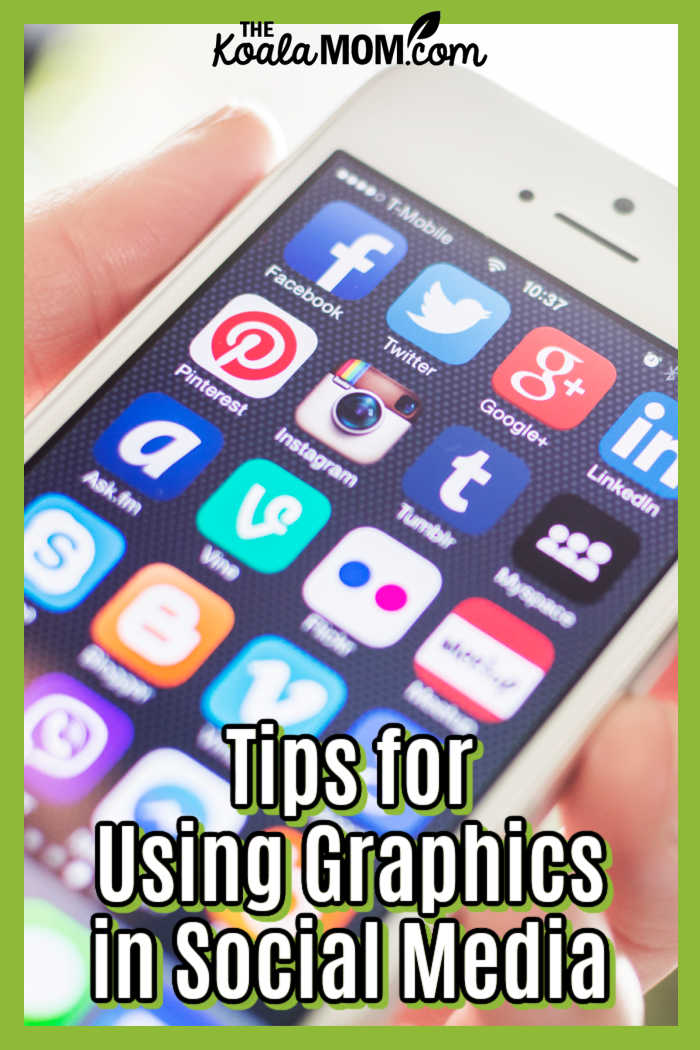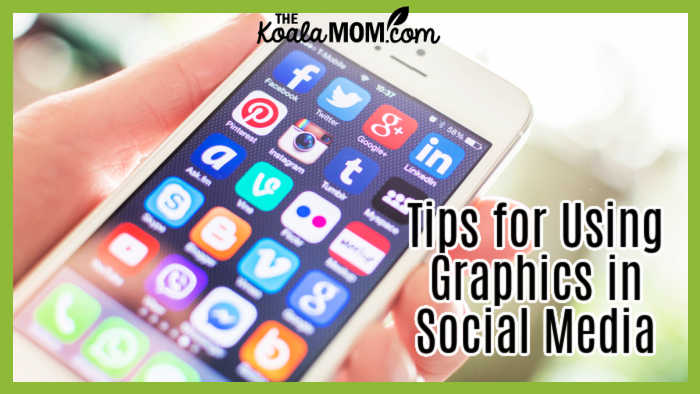Graphics are very important on every social media site. Pinterest and Instagram are driven purely by images; Facebook and Twitter posts with images get more clicks and engagement than posts without images. It goes back to the old saying that “a picture is worth a thousand words.” It’s easier to glance at an image than to read a sentence or paragraph, and so in our world of short-attention spans, graphics can’t be overlooked.

This post contains affiliate links; as an affiliate, I earn from qualifying purchases.
Here are my five tips for using graphics in social media.
1. Use the right size image.
There’s nothing more annoying than scrolling through my Twitter newsfeed and seeing the middle section of an image that has clearly been cropped to fit the newsfeed and now makes little sense. Each social media platform has its own ideal size for images; don’t use the same image for every site.
In general, Facebook and Twitter do better with short, wide images while tall, thin images are more effective on Pinterest. Picmonkey and other photo editing tools have social media templates to make it easy to customize your images for each site, but you can also download cheat sheets to make sure your images fit their target audience.
2. Watermark your image.
As a writer, copyright laws and respecting creativity are very important to me. Unfortunately, there are others who’d love to steal your beautiful images and use them without giving credit. You can make this a bit less likely to happen by watermarking your images. This is easy to do with photo editing programs (especially if you’re resizing your images before posting anyway!).
When I had a designer make my new logo, I also requested that they create a watermark for me. Now it’s easy to slap that image on any photo I use on my blog. You can also create your own watermark using Picmonkey or simply use a text watermark (check out Picmonkey’s tutorial on both those options).
3. Find great images.
High-quality images are important. I take most of my own pictures, mostly because I’m afraid of getting in trouble for using someone else’ images. You can be creative about taking pictures to use with blog posts; for example, I had Sunshine hold a rosary for this post about teaching kids to pray the rosary. Use a DSLR camera and natural light whenever possible for better photos.
When I’m really stuck with ideas for images, I’ll create a title image in Picmonkey, like I did for this post or my interview with another blogger.
It is possible to find free stock photos, but I’d caution you to carefully check copyright before using any pictures. I also find that many of the free stock photos are not as high quality as paid stock photos. I have a Depositphotos account and regularly top it up when they have a sale, so I can get high-quality images for less than $1 per photo. The image used in this post is from Depositphotos.

4. Be consistent with fonts and colors.
I used to randomly pick fonts and colors to go with the image I was creating. Now, however, I generally stick to two favourite fonts and usually black or white. Using consistent colors and fonts in your images helps to create a recognizable brand for yourself. For example, Nathalie Lussier’s colors are two shades of green.
5. Your most important social media image is…
The most important image you use on your social media accounts is your profile picture. Invest in a professional profile picture and use it across all your social media networking sites. You want your readers to recognize you, whether they meet you on Facebook or Twitter or LinkedIn.
Your photo should also convey your personality and be part of your brand. Don’t use a book cover, company image, or avatar as your profile picture, as those are impersonal and hard to relate to.

3 Comments
I agree with the profile photo. I love mine, and I try to change it up every couple of years. A professional headshot isn’t that expensive but it does send a message that you’re professional and businesslike. If someone is concerned about privacy issues, they can use an older, professional photo of themselves instead.
Thanks for these great tips, Bonnie. I will bookmark this post and keep it in mind!
Great tips and examples here, Bonnie. I especially appreciated your tip about watermarks. I’ve started to add my website, but could do more to let people know which graphics are original with me.